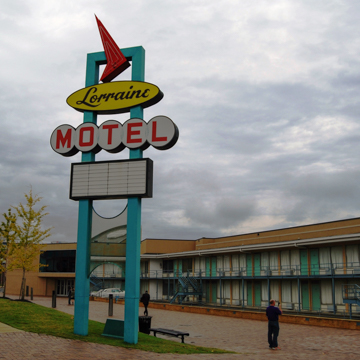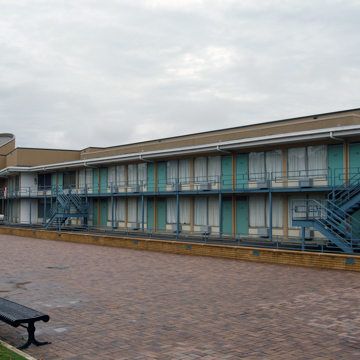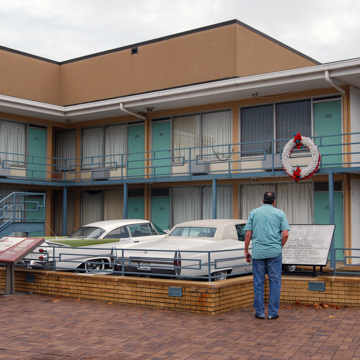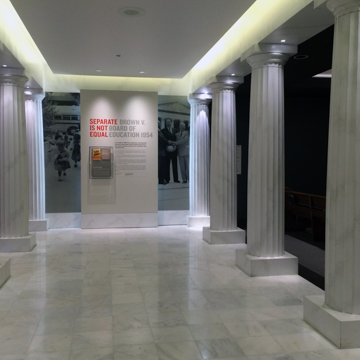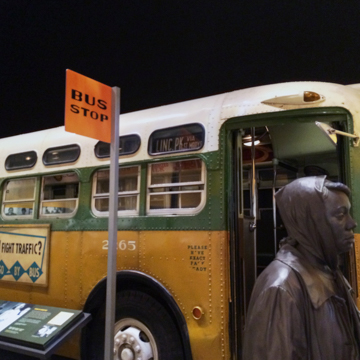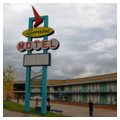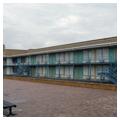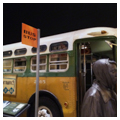You are here
Lorraine Motel
Located about four blocks from Beale Street, the historic African American commercial center in Memphis, the Lorraine Motel was where Martin Luther King Jr., Ralph Abernathy, and Andrew Young stayed in 1968 when they came to Memphis to support the city’s striking sanitation workers, most of whom were African American. On April 4, 1968, from a boardinghouse across Mulberry Street, James Earl Ray assassinated King while the civil rights leader stood on the upper balcony of the motel outside Room 306, a spot now marked with a white wreath. For decades after, this tragic event was the only reason people knew about the Lorraine, but in the 1990s, the motel became part of the National Civil Rights Museum and the building asserted a new and positive impact on the city of Memphis.
Sited south of Memphis’s central business district, the building was erected circa 1925. By the time Walter Bailey, an African American businessman, purchased the hotel two decades later, the demographics of Memphis were changing. After Bailey renamed the establishment for his wife Loree and the song “Sweet Lorraine,” it became prime lodging for African American visitors to the segregated city, and guests in the post–World War II period included prominent musicians and community leaders, who also patronized the hotel’s cafe. Beginning in 1952, the Lorraine was featured in annual issues of The Negro Travelers’ Green Book, a guide to facilities that welcomed and catered to African American motorists in an era when such information was necessary for personal safety.
Bailey expanded the Lorraine in 1955, adding sixteen rooms in a two-story concrete block wing built east of the original hotel. Twelve more rooms on a second story were added later, as were more guest rooms and drive-up access—turning this into a modern motel. The two-story structure was typical of motor hotels of the period, which catered to auto traffic with parking right outside one’s room and large plate glass windows that fronted exterior walkways. At the Lorraine, open metal stairs gave access to the rooms on the second level of the motel. Though architectural exuberance was not uncommon in motels of the 1950s, the Lorraine is stylistically modest. The exception is its multistory sign, which can be described as a Memphis response to California Googie. Towering over the motel, the open metal turquoise frame supports a red chevron at the top, a yellow oval with “Lorraine” in black script, and five white circles that spell “motel” in red capital letters.
After King’s assassination, Walter Bailey set Room 306 aside and the Southern Christian Leadership Conference placed a memorial plaque by its door on the exterior balcony. Though this informal shrine sometimes attracted visitors who wished to pay tribute to King’s life and work, Bailey struggled to keep the Lorraine Motel financially viable in the midst of widespread disinvestment in the surrounding commercial district. In the late 1970s, the Lorraine shifted to single-room occupancy and by 1982 it was in foreclosure.
That same year, a coalition of African American business and civic leaders mounted a “Save the Lorraine” campaign and purchased the building at auction for $144,000. In 1991 the motel was reopened as the National Civil Rights Museum. Part of the back of the building was demolished to make space for exhibits, collections, and special events spaces, but Room 306 was preserved. The museum expanded in 2002 and again in 2013–2014. With the Lorraine Motel at its heart, the National Civil Rights Museum has become an important institution anchoring the revitalization of what is now known as the South Main Historic Arts District, though some local activists have protested its role in fostering displacement and gentrification.
References
“About.” National Civil Rights Museum. Accessed April 5, 2018. http://civilrightsmuseum.org/.
Hobbs, Allyson. “The Lorraine Motel and Martin Luther King.” The New Yorker, January 18, 2016.
National Park Service. “Lorraine Motel.” We Shall Overcome: Historic Places of the Civil Rights Movement. Accessed April 5, 2018. https://www.nps.gov/.
The Negro Motorists Green Book. New York: Victor H. Green and Company, 1949.
Ostby, Lloyd, “South Main Street Historic District,” Shelby County, Tennessee. National Register of Historic Places Inventory–Nomination Form, 1982. National Park Service, U.S. Department of the Interior, Washington, D.C.
Writing Credits
If SAH Archipedia has been useful to you, please consider supporting it.
SAH Archipedia tells the story of the United States through its buildings, landscapes, and cities. This freely available resource empowers the public with authoritative knowledge that deepens their understanding and appreciation of the built environment. But the Society of Architectural Historians, which created SAH Archipedia with University of Virginia Press, needs your support to maintain the high-caliber research, writing, photography, cartography, editing, design, and programming that make SAH Archipedia a trusted online resource available to all who value the history of place, heritage tourism, and learning.

